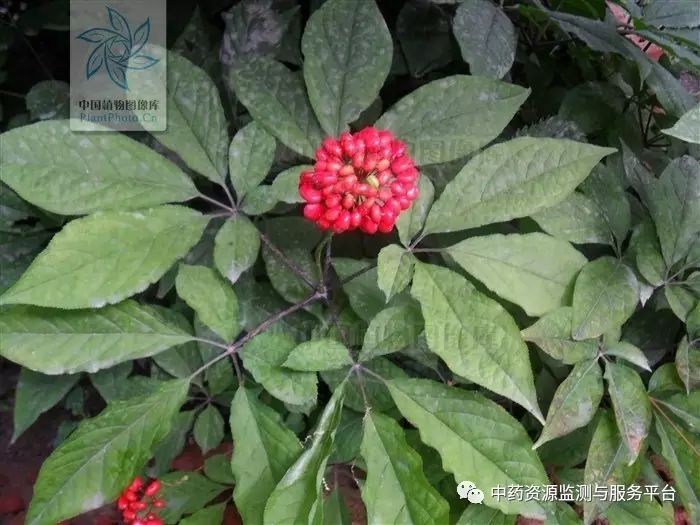Introduction to the Plant
Ginseng Panax ginseng C. A. Mey. is a plant of the Araliaceae family, belonging to the genus Panax. The medicinal parts are commonly the root, rhizome, and leaves. It is harvested in autumn, cleaned, and then sun-dried or oven-dried.Understanding the Plant
1
Morphological Description
Perennial herb; the rhizome (bulb) is short, upright or oblique, and does not thicken into a tuber. The main root is fleshy, spindle-shaped or cylindrical. The above-ground stem is solitary, 30-60 cm tall, with longitudinal ridges, hairless, and has persistent scales at the base. The leaves are palmate compound, with 3-6 leaflets whorled at the top of the stem; juvenile plants have fewer leaves; the petiole is 3-8 cm long, with longitudinal ridges, hairless, and without stipules at the base; leaflets are 3-5, often 3 in juvenile plants, membranous, with the central leaflet being oval to oblong-oval, 8-12 cm long and 3-5 cm wide, while the outer pair of lateral leaflets are ovate or rhomboid-ovate, 2-4 cm long and 1.5-3 cm wide, with a gradually pointed apex, broad wedge-shaped base, and serrated margins with sharp teeth. The upper surface has a few scattered bristles about 1 mm long, while the lower surface is hairless. There are 5-6 pairs of lateral veins, prominent on both sides, with the reticulate veins not obvious; the petiole of the leaflets is 0.5-2.5 cm long, with the lateral ones being shorter. The umbel inflorescence is solitary and terminal, about 1.5 cm in diameter, with 30-50 flowers, rarely 5-6; the total flower stalk is usually longer than the leaves, 15-30 cm long, with longitudinal ridges; the flower stalk is thread-like, 0.8-1.5 cm long; the flowers are pale yellow-green; the calyx is hairless, with 5 triangular teeth at the edges; there are 5 petals, ovate-triangular; 5 stamens with short filaments; the ovary is 2-celled; the style is 2, free. The fruit is flattened-spherical, bright red, 4-5 mm long and 6-7 mm wide. The seeds are kidney-shaped and milky white.
2
Geographical Distribution
Distributed in eastern Liaoning, eastern Jilin, and eastern Heilongjiang, growing in deciduous broadleaf forests or mixed coniferous and broadleaf forests at altitudes of several hundred meters. Currently, it is widely cultivated in Jilin and Liaoning, with introductions in Hebei and Shanxi. It is also found in the Soviet Union and Korea; Korea and Japan also cultivate it extensively.
3
Medicinal Parts
Root, rhizome, leaves
4
Chinese Herbal Pieces
Ginseng slices, ginseng leaves
5
Properties and Channels Entered
Ginseng slices: sweet, slightly bitter, slightly warm. Enter the spleen, lung, heart, and kidney channels.
Ginseng leaves: bitter, sweet, cold. Enter the lung and stomach channels.
6
Functions and Indications
Ginseng slices: greatly tonify the original qi, restore the pulse and stabilize collapse, tonify the spleen and benefit the lungs, generate fluids and nourish the blood, calm the spirit and enhance intelligence. Used for deficiency of qi leading to collapse, cold limbs with weak pulse, spleen deficiency with poor appetite, lung deficiency with cough and asthma, fluid damage with thirst, internal heat with diabetes, deficiency of qi and blood, prolonged illness leading to weakness, palpitations and insomnia, impotence and cold uterus.
Ginseng leaves: tonify qi, benefit the lungs, dispel summer heat, generate fluids. Used for qi deficiency cough, summer heat irritability, fluid damage with thirst, dizziness, and fatigue in the limbs.
Disclaimer:This article is excerpted from “Flora of China” and the 2015 edition of “Chinese Pharmacopoeia”. The source of the images is indicated by watermarks. Published by the Chinese Herbal Resource Monitoring and Service Platform. If the author or editor believes that their work should not be published on the WeChat platform or should not be used without compensation, please contact us: [email protected].The Chinese Herbal Resource Dynamic Monitoring System (http://zyzyfwb.com/herbs/)
【Chief Editor】 Li Junde 【Editing and Compilation】Shen Yihua, Lin Zhongbin, Zhang Tian

↓↓↓ Click “Read the original text” 【to view historical messages】

